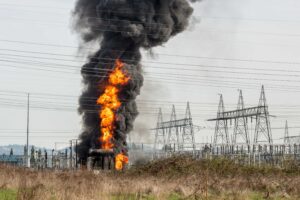March 23, 2025 – Too Hot to Handle
![]() by Jake Ring, PDM Co-founder and President
by Jake Ring, PDM Co-founder and President
What we know
The fire that caused significant disruption at Heathrow Airport two days ago occurred at an electrical substation approximately 1.5 miles away. The blaze involved a transformer containing 25,000 liters of oil, which was fully ablaze. Energy experts suggest that a fault in a transformer operating at 275,000 volts likely ignited the oil-fueled fire. The transformer was converting 275,000 volts to 66,000 volts when it seemingly failed.

Age of Obsolescence
When I was at GE back in 2012, we did a study on the US market for power distribution based on the potential growth of electric vehicles on the back of the Nissan Leaf’s launch. What we found was that most of the transformers powering the grid were rapidly approaching 48 to 50 years of age. This is twice the 25-year useful lifespan that transformers of that era were designed to have.
Bad Harmony
When a utility substation transformer ages beyond their useful life, the transformer is subjected to greater harmonic frequency and harmonic distortions. Total harmonic distortion values can reach a peak at which point the power on the load side is seeking ground and will find it most easily through the transformer which cause these low thermal arcs.
Arcing activities within the transformer tank, characterized by internal discharges, gradually reduce the dielectric or insulating strength of the transformer’s oil. This process causes arcs to strike the paper insulation of the transformer coil windings, leading to fragmentation and a subsequent increase in contaminants such as acetylene, benzene, and hydrogen.
Along with the paper fragments reducing the dielectric strength of the insulating oil, it can also lead to higher temperatures, especially for a low-capacity transformer that is being tasked with a greater amount of power draw. This can happen overtime and is an indication of a transformer that is likely beyond its life expectancy.
How old was the Heathrow Transformer?
I wouldn’t be surprised if this Heathrow transformer was over 40 years in age. A transformer of this advanced age could be compromised to the point the level of harmonic frequencies on the low side of the transformer can impact its performance and cause it to fail, overheat, or even explode due to the pressure built up inside.
How hot is too hot?
Transformers can generally support temperatures up to 300 degrees Celsius, especially if uses Type 2 mineral oil.
Oil insulator breaks down
Some transformers can withstand this arcing effect on a continuous duty basis. But in cases where this elevated power push causes a greater amount of harmonic distortion and arc affect, it can lead to higher temperatures to the point that the oil starts to break down.
When the dielectric breaks down, there’s nothing preventing the electricity from flowing from the high-potential point to the low-potential point, causing an arc. This is how overheating occurs. The oil becomes very hot and releases steam which increases the pressure inside the unit. The steam is forced out through the pressure relief valve. So now you’ve got hot oil steam landing on a hot transformer and that could cause a critical failure or worse, become flammable as in the case of the Heathrow transformer.
Unfortunately, our aging electrical grid could be at similar risk whenever obsolete transformers exist.

